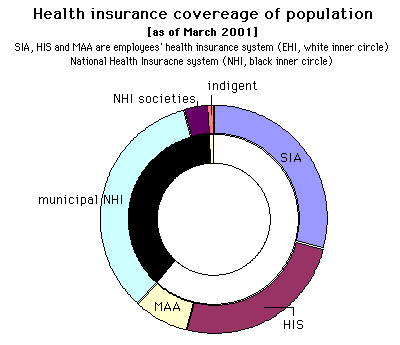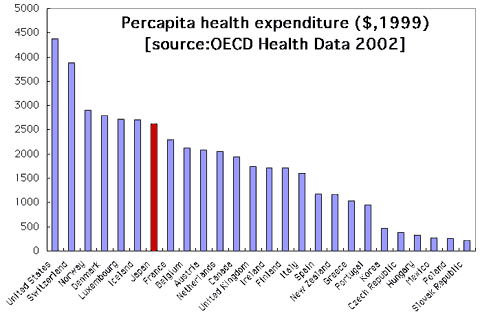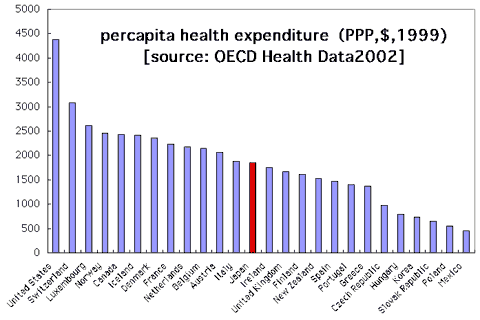|
Chapter 5. Health Economics |
| 1. Health Insurance and Health Care Financing | |||||||||||||||||||||||||||||||||||||||||||||||
|
Japan has a national health insurance system that covers the entire population since 1961. The health insurance system not only finances the health care but also serves as a "defacto" policy implementation tool to enable the government to macro-manage the behavior of hospitals and clinics in the entire nation through the uniform fee schedule. Although the health insurance system covers the entire population, it is by no means a single unified system. Instead, it is a fragmented system consisting of different insurers covering different segments of the population. The system consists of two major pillars: The Employees' Health Insurance (EHI) that covers employed working population and their dependent family members and The National Health Insurance (NHI) that covers non-employed population. The EHI is further divided into Health Insurance Societies (HIS) that are established in major corporations and the Social Insurance Agency (SIA) that covers employees and medium to small sized corporations. For civil servants, Mutual Aid Association (MAA) provides coverage equivalent to HISs. The NHI is further divided into municipal governments and NHI societies that are established by some occupational association such as doctors, dentists, lawyers and self-employed construction workers. Roughly the SIA, HISs and municipal NHI each cover 30% of the population totaling to 90% and MAAs cover 9%. The rest 1% are indigent people who are covered by the means-tested welfare system.  The distribution of enrollment to different insurance system is heavily affected by economic situation. When the job market is bad, there is a migration from EHI to NHI. Due to the long-lasting economic slump, the enrollment of NHI is increasing. Nearly two million people migrated from EHI to NHI during one year ended in May 2002. With no improvement in the job market in sight for the foreseeable future, the migration toward NHI will continue. |
|||||||||||||||||||||||||||||||||||||||||||||||
| 2. Benefit and reimbursement system | |||||||||||||||||||||||||||||||||||||||||||||||
|
The benefit of Japan's health insurance system is comprehensive and universal: one can safely assume that all medical services including dental care and outpatient medication are covered to all nation regardless of the insurance system. The reimbursement is basically fee-for-service and the government sets the national uniform fee schedule as well as the price list of all drugs covered by insurance (unfortunately Viagra is not covered). There is no capitation payment like British NHS nor manage-care arrangement as seen in the U.S.. The fee schedule is revised every two years through the negotiation between the government and the provider sides (Japan Medical Association etc). The fee schedule revision is important in health policy making because not only it change the price but also it implements certain health policy. For example, the government may be able to encourage doctors over the country to provide more house calls through economic incentives by raising the price for house calls. The year 2002 coincided with the fee schedule revision year and charges of typical cases were presented for reference by MHLW. |
|||||||||||||||||||||||||||||||||||||||||||||||
|
Charge for typical cases (yen, $1=125yen)
[source: documents presented by MHLW to explain the fee schedule revision. March 2002]
|
|||||||||||||||||||||||||||||||||||||||||||||||
|
|||||||||||||||||||||||||||||||||||||||||||||||
|
Reimbursement is not 100%. Patients are required to pay a certain specified copayment whenever they receive treatment. The copayment varies from 10 to 30% with monthly cap, beyond which the overpayment will be refunded by insurers upon request. Hospitals and clinics will submit claims for direct reimbursement to the insurers. Practically, insurers do not handle the claims, instead they maintain clearinghouses for claims processing. All hospitals and clinics will submit all the claims to the clearing houses established in each of 47 prefectural level. Clearinghouses are authorized to audit the claims to verify the content of the claims, after then the reimbursement will be paid to each hospital or clinic. Claims must be submitted every calendar month. The total number of such claims is well over one billion per year (!). Unfortunately, computerization of claims is poorly developed despite the governmental efforts. Most claims are still submitted in paper form and are reviewed and processed manually. |
|||||||||||||||||||||||||||||||||||||||||||||||
| 3. National Health Care Expenditure | |||||||||||||||||||||||||||||||||||||||||||||||
|
The government estimates the total disbursement of health care cost paid to hospitals, clinics and other related health care providers such as pharmacies and independent visiting nursing stations, which is called the National Health Care Expenditure (NHCE). The estimated total of NHCE in 2000 was 30 trillion yen or approximately 250 billion dollars or 250,000 yen (2,000 dollars) per capita, which constitutes 8% of Japan's National Income (NI) and 7% of GDP. Although this figure may seem as reasonable particularly in comparison with the U.S., one should be reminded that the scope of NHCE is much more narrowly defined than the national health expenditure of the U.S.. Japan's NHCE is strictly limited to the cost paid by public financing system to health care providers and does not include private payment such as glasses and contact lens, OTC drugs, add-on payment for amenity. According to the estimate made by the Institute of Health Economics and Policy (IHEP), the NHCE is underestimated by at least 10% from the more broadly defined health care expenditure of other countries. The government has set a policy goal of controlling the growth of NHCE in parallel to the growth of the National Income so as not to strain the household. The percent of the NHCE per NI was 6% in 1990, when the bubble economy boosted the national income, but has increased steadily since then to 8% in 1999. Given the long lasting economic slump coupled with the rapidly aging population, the burden of health care cost will inevitably continue to grow in the foreseeable future. As for the financial source, the NHCE is broken down to insurance premium 54%, general tax revenue 32% and patients' out-of-pocket 14%. The share of patients' out-of-pocket is growing due to the increased copayment of the health insurance system. |
|||||||||||||||||||||||||||||||||||||||||||||||
| 4. International comparison of health expenditure | |||||||||||||||||||||||||||||||||||||||||||||||
When exchanged to US$, Japan's per capita national health expenditure is ranked higher than major European countries. Interestingly, though, Japan slips between Italy and the U.K. when transformed into PPP (purchasing power parity, adjusted by consumer price index). This reflects Japan's high consumer price index. Ironically put, everything is expensive in Japan including both daily commodity and medical expenses, making the health care cost "relatively" less expensive from the consumer's standpoint.  |
|||||||||||||||||||||||||||||||||||||||||||||||
| 5. Health care reform -A mandate for change | |||||||||||||||||||||||||||||||||||||||||||||||
|
Japan's health insurance system is "universal but fragmented" system. It is universal in that it guarantees that every single person is insured and that the same coverage of medical care is guaranteed to every body, but it is fragmented in that there is a considerable inequality as to the premium burden. The system has basically been in place since the prewar period without any radical reforms. Historically there has been a proposal for total unification of fragmented insurance system to achieve equality of burden but such proposal has always been hindered by opposition mainly from industry side that represents EHI. The problems has been worsened by rapidly aging population, i.e. because majority of employees will retire by the age of around 60 years old and eventually enroll to municipal NHI, municipal NHI is chronically burdened by high enrollment of elderly population. In 1983, a new system, the Elderly Health Act was enacted and introduced a financial redistribution mechanism to balance the inequality of elderly enrollment, in which insurers with less elderly enrollment (mostly EHI) will be required to contribute "dowry" for their elderly enrollees to help finance the elderly enrollees of other insurers. This system did stabilize the financial plight of NHI, but it remained essentially a patchwork and the situation has only got worse. Currently 27% of municipal NHI enrollees are elderly aged 70 or over while the percentage is around 3% for HISs. A call for radical restructuring of the fragmented health insurance system grew louder and louder. In 2002, as a political compromise of revising the health insurance laws to increase patients' copayment, the revision included a mandate that a radical reform plan should be completed by March 2003. In September 2002, MHLW minister Sakaguchi disclosed his own personal proposal for the nation to debate. Sakaguchi proposal was to consolidate the present municipal NHI and the government managed health insurance run by SIA at prefectural level by 2007 and eventually seeks total unification of fragmented system. If this proposal were realized the long-awaited unification would be achieved. It is too premature to predict how much chance the minister's proposal will have, but at least the debate over the radical reform of Japan's health insurance system will be intensified around his proposal. The mandate set the deadline to allow only two years for national discussion. |
|||||||||||||||||||||||||||||||||||||||||||||||
  
|